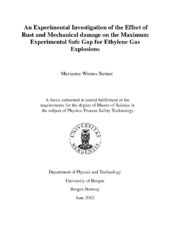| dc.description.abstract | Gas explosions are a great hazard in the industry where flammable substances are handled. Engines, switches and other electrical equipment can act like ignition sources where an explosive atmosphere is present. Possible ignition sources are placed in flameproof enclosures which are designed to withstand an internal explosion and prevent transmission of hot combustion products to ignite an explosive outer atmosphere. All flameproof enclosures have to fulfill the requirements given by the international standard. The current international standard (IEC 2011) require that the maximal average roughness (Ra) of a flame gap surface is <-6.3my m. Any damaged flame gap must be brought back to its original state. The current standard (IEC) gives no technical argument to justify the requirements of an average roughness <- 6.3my m. Previous experimental work (Grov 2010; Opsvik 2010; Solheim 2010) has shown that the gap efficiency has in fact improved when applying rust and mechanical damage to the flame gap surfaces so that the average roughness is greater than 6.3my m. In those experiments, propane has been used as the test gas. The purpose of the present experimental work is to investigate what effect rust and mechanical damage have on the efficiency of the flame gap to prevent a re-ignition of an explosive ethylene/air mixture. Ethylene is a highly reactive gas. The maximum experimental safe gap (MESG) of an explosive gas mixture is the largest gap width which prevents transmission of an internal explosion to the external atmosphere. The MESG is usually used to compare different gases. In the present investigation the MESG is used as parameter to compare how different damages affect the MESG value compared to an undamaged flame gap. If the MESG increases it means that gap efficiency increases, and if the MESG decreases the gap efficiency decreases. All of the experiments in the present work were performed in the Plane Rectangular Slit Apparatus with ethylene as the test gas. Flame gaps were explosion tested before and after rusting. The results showed a decrease in the number of re-ignitions after corrosion. None of the rusted slits gave re-ignition on the first explosion test, which is the most important. The main conclusion is that rust increased the efficiency of the flame gap to prevent a re-ignition in the secondary chamber. Experiments on mechanically milled crosswise grooves with different depth showed that the MESG value increased for the slits with the deepest grooves. One slit which had the smallest value of depth, had the same MESG value as for an undamaged slit. This means that crosswise grooves did not reduce the efficiency of the gap, and that the slit with deepest grooves in fact increased the efficiency. The overall conclusion from this experimental work is that surface roughness above the requirement given by the IEC standard does not reduce the efficiency of the flame gap for an internal ethylene gas explosion. | en_US |
